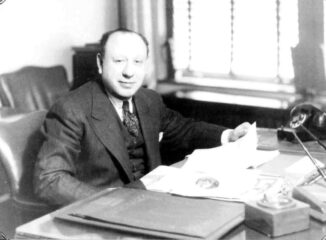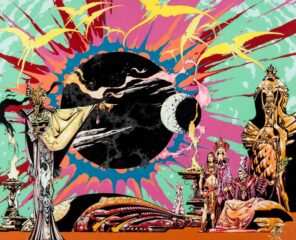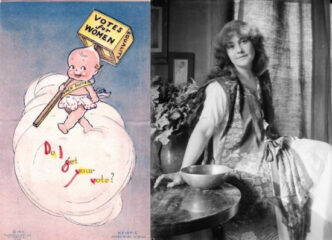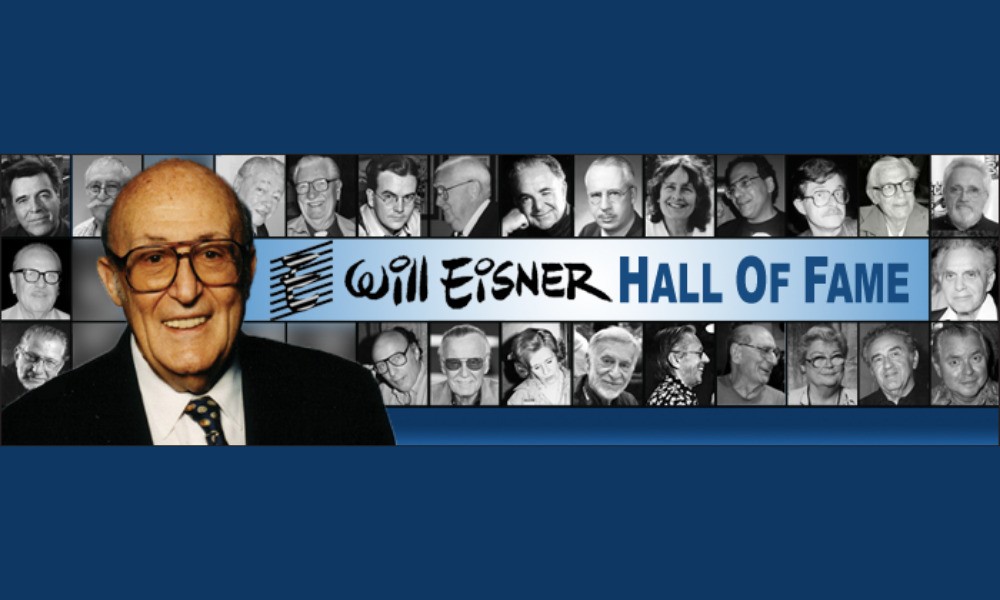Comic-Con International (Comic-Con) announced that the Eisner Awards judges have selected six individuals to automatically be inducted into the Will Eisner Comic Awards Hall of Fame for 2022. Trophies will be presented in a gala awards ceremony held during Comic-Con in San Diego, on the evening of July 22.
These inductees include two deceased comics artists: EC founder/publisher Max Gaines (who devised the first four-color, saddle-stitched newsprint comic in 1933) and writer Mark Gruenwald (legendary Marvel Comics editor); two pioneers of the comics medium: British illustrator Marie Duval (co-creator in 1867 of the British cartoon character “Alley Sloper,” considered the first recurring cartoon character); cartoonist Rose O’Neill (creator of The Kewpies in 1912); and two living legends: Filipino American artist Alex Niño (DC, Marvel, Warren, Heavy Metal etc.) and artist P. Craig Russell (best known for Elric, his adaptations of opera to graphic novels, and his collaborations with Neil Gaiman, including on The Sandman, Coraline, American Gods and Norse Mythology).
The judges have also chosen 17 nominees from whom voters will select 4 to be inducted in the Hall of Fame this summer. These nominees are:
- Howard Chaykin, creator of “Cody Starbuck” (Star*Reach), graphic novel pioneer (The Stars My Destination, Empire), artist of the first Star Wars comics.
- Gerry Conway, co-creator of Marvel’s “The Punisher” and “Ms. Marvel”, DC’s “Power Girl” and “Killer Croc.” Wrote the death of Gwen Stacy and pioneering crossover Superman vs. the Amazing Spider-Man.
- Kevin Eastman, co-creator of Teenage Mutant Ninja Turtles. Founder of Tundra Publishing. Former owner and publisher of Heavy Metal.
- Steve Englehart, 1970s Marvel writer hired by DC to revamp their core characters. Creator of Coyote, Scorpio Rose, The Djinn and The Night Man. Writer for the Street Fighter, GI Joe and Team Atlantis animated series.
- Moto Hagio, shoujo manga pioneer. Creator of Heart of Thomas, A Drunken Dream, They Were Eleven and Otherworld Barbara. First woman comics creator to receive the Japanese Medal of Honor with Purple Ribbon. Helped shape the style of symbolic backgrounds used in manga today.
- Larry Hama, writer/artist/editor/actor whose titles include G.I. Joe, Wolverine, Avengers, Conan, Batman, Wonder Woman, X-Men, Spider-Man and many more.
- Jeffrey Catherine Jones (1944-2011) creator of recurring comic strips in National Lampoon ( Idyl) and Heavy Metal (I’m Age), artist for Creepy, Eerie and Vampirella, and cover painter for more than 150 books. In the late 1990s, she undertook medical gender affirmation and embraced life as a woman.
- David Mazzucchelli, regular Daredevil artist who worked on Frank Miller’s Born Again arc as well as Batman: Year One. Created the anthology Rubber Blanket and award-winning graphic novel Asterios Polyp.
- Jean-Claude Mézières (1938-2022), co-creator of Valerian and Laureline; concept artist on major motion pictures including Luc Besson’s The Fifth Element.
- Grant Morrison, comics writer whose many credits include Doom Patrol, Arkham Asylum: A Serious House on Serious Earth, New X-Men, All-Star Superman; his most recent projects include Happy! (Image), adapted as a TV series on Syfy.
- Gaspar Saladino (1927-2016), a letterer and logo designer for more than 60 years on titles including Swamp Thing, The Flash, Hellblazer, Green Lantern, Batman, Teen Titans, Metal Men and The Avengers.
- Jim Shooter, editor-in-chief of Marvel (1976-1987) and founder of Valiant Comics, Defiant Comics and Broadway Comics. Shooter began his career selling stories to DC Comics at just 14 years old.
- Garry Trudeau, creator of the comic strip Doonesbury, published in over 400 newspapers nationwide. The first comic artist to win the Pulittzer Prize, and a strong advocate for cartoonists’ rights.
- Ron Turner, founder of San Francisco-based label Last Gasp (1970), publisher, distributor and wholesaler of underground comix and books. Publisher of Slow Death, Wimmen’s Comix and Weirdo.
- George Tuska (1916-2009), artist for the Iger-Eisner Studio, Harry A Chelser Studio, Crime Does Not Pay, Doc Savage, Scorchy Smith, Buck Rogers, Ghost Rider, X-Men and the daily Superman (until 1993).
- Mark Waid, writer/editor for Amazing Heroes, The Flash, Captain America, Fantasic Four, Superman: Birthright. Former editor-in-chief/CCO of BOOM! Studios, currently publisher for Humanoids.
- Cat Yronwode, writer, editor and comics scholar who penned the long-running “Fit to Print” column in Comics Buyer’s Guide; author of The Art of Will Eisner and Women and the Comics (with Trina Robbins). Editor-in-chief of Eclipse Enterprises, which published Miracleman, The Rocketeer and Zot!.
More information on the nominees can be found here. The deadline for voting is May 11. (New voters must have registered by May 5 in order to be invited to the ballot.)
The 2022 Eisner Awards judging panel consists of comics writer/editor Barbara Randall Kesel, author/art historian Kim Munson, writer/editor/journalist Rik Offenberger, librarian Jameson Rohrer, comics journalist/historian Jessica Tseang and retailer Aaron Trites.
Eisner Hall of Fame 2022: Judges’ Choices

Max Gaines (1894–1947) devised in 1933 the first four-color, saddle-stitched newsprint pamphlet, a precursor to the color-comics format that became the standard for the American comic book industry. He was co-publisher (with Jack Liebowitz) of All-American Publications, a seminal comic-book company that introduced such enduring fictional characters as Green Lantern, Wonder Woman, and Hawkman. He went on to found Educational Comics, producing the series Picture Stories from the Bible. He authored one of the earliest essays on comic books, a 1942 pamphlet titled Narrative Illustration, The Story of the Comics. After Gaines’ death (in a motorboating accident) in 1947, Educational Comics was taken over by his son Bill Gaines, who transformed the company (now known as EC Comics) into a pioneer of horror, science fiction and satirical comics.

Mark Gruenwald (1953–1996) was hired by Marvel Comics in 1978 and stayed there until his death. During his tenure, he worked on a variety of books before becoming their executive editor and keeper of continuity for much of the 1980s. Gruenwald had a knack for remembering every bit of minutia about Marvel Comics. The publisher even opened up a challenge for readers to stump him but had to discontinue it when it became clear nobody could beat him. Gruenwald is most recognized for his work on a new team of heroes known as the Squadron Supreme. The Squadron’s characters had been around, but Gruenwald decided to focus on a new set of the heroes in an alternate reality. The Squadron Supreme received a 12-issue miniseries and is considered a precursor to highly popular deconstructionist superhero parables like Watchmen, Kingdom Come and The Boys. Sadly, Gruenwald died of heart failure in 1996. He had long told his wife he wanted his ashes to be a part of his work. When Squadron Supreme was collected into a trade paperback, his ashes were mixed into the ink.

Alex Niño was among the Philippine comics artists recruited for U.S. comic books by DC Comics editor Joe Orlando and publisher Carmine Infantino in 1971. Niño’s earliest DC work was drawing stories for House of Mystery, Weird War Tales and other supernatural anthologies, as well as the jungle-adventure feature “Korak” in Tarzan. He moved to the U.S. in 1974. Over the next several decades, Niño drew all types of stories for DC, Marvel, Warren (Creepy, Eerie, Vampirella), Heavy Metal, Byron Preiss, Dark Horse Comics and other publishers. Starting in the 1980s, Niño branched out into movies and video games, doing design work and concept art for Hanna-Barbera, Sega and Walt Disney Pictures (Mulan and Atlantis). Niño received an Inkpot Award in 1976.

P. Craig Russell has spent 50 years producing graphic novels, comic books and illustrations. He entered the comics industry in 1972 as an assistant to artist Dan Adkins. After establishing a name for himself at Marvel on Killraven, Dr. Strange and Elric, Russell began working on more personal projects, such as adaptations of operas by Mozart (The Magic Flute), Strauss (Salome) and Wagner (The Ring of the Nibelung). Russell is also known for his Fairy Tales of Oscar Wilde series and his graphic novel adaptations of Neil Gaiman’s The Sandman: The Dream Hunters, Coraline, Murder Mysteries and American Gods. His most recent project has been Gaiman’s Norse Mythology for Dark Horse. Russell received an Inkpot Award in 1993 and has won several Harvey and Eisner awards.

Pioneer Marie Duval (1847–1890) was born Isabelle Emilie Louisa Tessier in Marleybone, London in 1847. Tessier was one of the first female cartoonists in Europe. Her fame rests on her contributions to the Ally Sloper comic pages created with her husband Charles Henry Ross in the comic periodical Fun, and reprinted in a shilling book, Ally Sloper: A Moral Lesson (full title: Some Playful Episodes in the Career of Ally Sloper late of Fleet Street, Timbuctoo, Wagga Wagga, Millbank, and elsewhere with Casual References to Ikey Mo) in November 1873. This work is often called “the first British comic book.” The idea of a recurring, familiar cartoon character — so basic to comics and cartoons as we know them now — appears to have begun with Ally Sloper. The wildly popular character (a hard-drinking working class shirker) is thought to have inspired both Charlie Chaplin’s Tramp persona and W. C. Fields. Besides Ally Sloper, Marie Duval drew a range of comic fantasies (“caricatures”) for the magazine Judy, a Victorian rival to Punch.

Pioneer Rose O’Neill (1874–1944) was an American cartoonist and writer who, at a young age, became the best-known and highest-paid female commercial illustrator in the United States. A four-panel comic strip by O’Neill were featured in a September 19, 1896, issue of Truth magazine, making her the first American woman to publish a comic strip. She earned her international fame and fortune by creating the Kewpie, the most widely known cartoon character until Mickey Mouse. Her Kewpie cartoons, which made their debut in a 1909 issue of Ladies’ Home Journal, were made into bisque dolls in 1912 by J. D. Kestner, a German toy company. The dolls became immediately popular and are considered to be one of the first mass-marketed toys in the United States.








 Win 'The Art of DreamWorks Dog Man'!
Win 'The Art of DreamWorks Dog Man'! 

